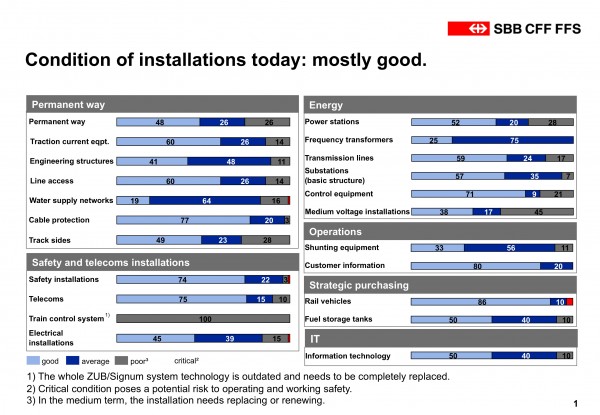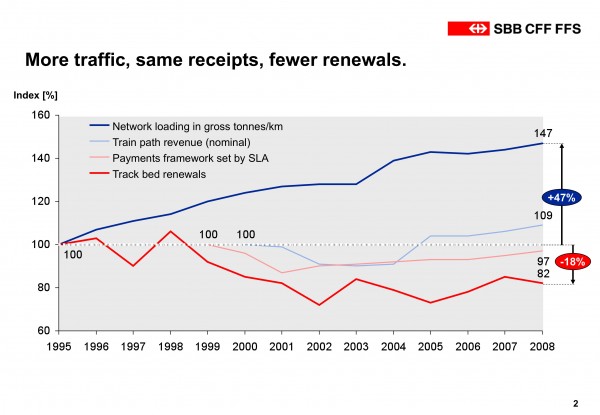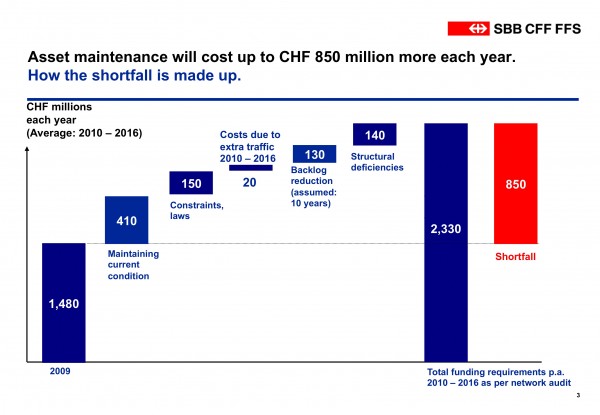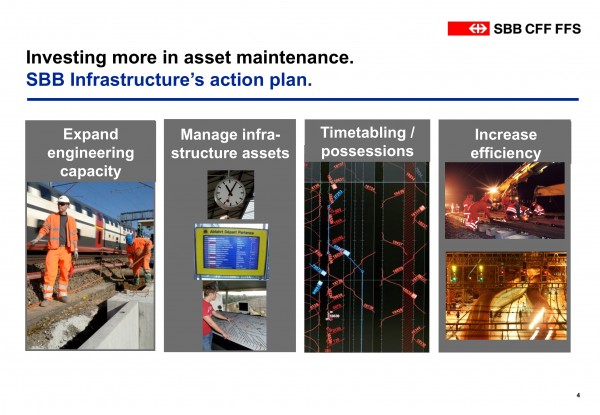Taking the ‘action not reaction’ future approach
Posted: 4 August 2010 | | No comments yet
Most of the SBB rail network is in good condition. That was the conclusion of an external survey commissioned by SBB and published in February 2010. Future maintenance and renewal of the rail infrastructure will cost significantly more than was previously assumed. SBB Infrastructure has embarked on a comprehensive action plan designed to meet the increased requirements. Philippe Gauderon, Head of SBB Infrastructure and Member of the SBB Management Board, summarised the task ahead as follows: “In future, ‘action not reaction’ will be our motto.”
Most of the SBB rail network is in good condition. That was the conclusion of an external survey commissioned by SBB and published in February 2010. Future maintenance and renewal of the rail infrastructure will cost significantly more than was previously assumed. SBB Infrastructure has embarked on a comprehensive action plan designed to meet the increased requirements. Philippe Gauderon, Head of SBB Infrastructure and Member of the SBB Management Board, summarised the task ahead as follows: “In future, ‘action not reaction’ will be our motto.”
Most of the SBB rail network is in good condition. That was the conclusion of an external survey commissioned by SBB and published in February 2010. Future maintenance and renewal of the rail infrastructure will cost significantly more than was previously assumed. SBB Infrastructure has embarked on a comprehensive action plan designed to meet the increased requirements. Philippe Gauderon, Head of SBB Infrastructure and Member of the SBB Management Board, summarised the task ahead as follows: “In future, ‘action not reaction’ will be our motto.”
Swiss Federal Railways (SBB) operates the busiest and most heavily used rail network in the world. Between 8,000 and 9,000 trains run on SBB’s network of over 3,000 route kilometres every day, carrying approximately 880,000 passengers to their destinations. In addition, SBB transports 150,000 tonnes of freight each day on its network. These are world-beating figures – and are still rising. But they come at a price. To ensure that passenger and freight traffic on this densely utilised network remains punctual and safe, SBB Infrastructure is already investing around CHF 1.48 billion each year in maintenance, i.e. ensuring the functional capability and availability of installations including their upkeep and renewal.
The external network audit
As early as autumn 2008, internal surveys indicated that the financial resources needed to maintain the rail network and the associated rail infrastructure would probably rise substantially in the future. Consequently, in April 2009, SBB commissioned the Roland Berger management consultancy and the consulting engineers, Basler + Partner, to analyse the condition of the infrastructure, from the permanent way to the safety and telecoms installations, power supplies, management, strategic procurement and information technology. The Swiss Federal Office of Transport (FOT), the SBB’s supervisory authority, was also involved in the project.
The network audit had three main objectives:
- To assess the condition of SBB Infrastructure’s installations
- To identify the ‘resource backlog’. This is taken to include essential expenditure to raise the condition of a particular infrastructure category from its current condition to an ideal condition
- To calculate the annual funding required to maintain the rail infrastructure compared with SBB Infrastructure’s existing mediumterm financial plans.
The external consultants employed a variety of analytical methods in two phases to examine 22 of SBB Infrastructure’s various infrastructure categories. The first (top-down) phase involved carrying out a general assessment of their condition. The second (bottom-up) phase of the network audit involved a detailed examination of the important types of infrastructure categories and included evaluating disruptions to operations, carrying out on-site inspections, holding discussions with experts and with staff with particular knowledge of the regional organisation, and identifying the potential for efficiency enhancements.
Installations in good condition
The final network audit report gave the SBB Infrastructure installations a good rating overall. The study concluded that the installations were for the most part in a good and safe condition. Three quarters of the 22 infrastructure categories examined were in the two top assessment bands of ‘good’ or ‘average’. The external consultants found only isolated instances of installations in a critical condition. In this context, ‘critical’ means that, under unfavourable circumstances, their condition could put operational or workplace safety at risk. Plans for appropriate action to improve those categories affected are either in place or in some cases are already being implemented. The ‘train control system’ category was classed by the network audit as ‘poor’, with a recommendation that the systems should be replaced in the next few years because – from the technical point of view – they have reached the end of their service life. SBB therefore intends to introduce the standard European Train Control System (ECTS) throughout its network by 2017.
But: material assets are deteriorating at an accelerating rate
The external network audit has shown at various levels that substantially more resources will need to be spent on maintaining the SBB Infrastructure installations in future than are envisaged in SBB’s current medium-term plans and in the service level agreement with the federal government. The in-depth analysis of the permanent way shows that its condition has deteriorated in recent years. For example, the number of occasions on which tracks were found to be distorted and rails cracked, due to the condition of the infrastructure, rose by more than two thirds in the period between 2005 and 2008. Also, the number of lines throughout Switzerland which are subject to speed restrictions which has serious implications for the timetable, particularly in the core network – has risen from 12 to 20 since 2005. Furthermore, over the same period, the average time that the speed restrictions remain in place has increased from 2 to 6 months. Over the past 10 years, the comparative vertical and horizontal alignment of the tracks, known as track bed quality, has also worsened. Track bed quality is currently assessed as less than ‘good’ in just over half of the network. All these examples point to an acceleration in the rate at which the SBB’s permanent way is deteriorating.


Condition of installations today: mostly good.
Investment backlog of CHF 1.35 billion
The network audit has also calculated that a financial backlog totalling CHF 1.35 billion for rail infrastructure maintenance has arisen in the last 15 years. This equates to roughly 1.8% of the replacement value of all SBB Infrastructure installations. A backlog can be said to exist if, for example, uneconomical repairs are carried out in order to postpone renewing a section of track bed for a few years. Most seriously affected is the ‘permanent way’ infrastructure category, which accounts for CHF 825 million of the overall backlog. According to the network audit, the figures for electrical installations and the water supply network run to three-figure millions.
Network load has risen by 47%
Over the past 15 years, traffic loads on the SBB network have risen by 47% overall. The volume of traffic between Basel and Olten, for example, has more than doubled since 1980. This growth in traffic affects the rail infrastructure both directly and indirectly; directly, because increased traffic affects the rate of wear and thus the service life of the installations, especially the permanent way; and indirectly, constant growth in traffic means that ever shorter intervals are available for carrying out maintenance work, increasing costs still further.
In addition, permanent way construction costs have risen hugely in recent years, general inflation in the Swiss economy accounting for around one third of the rise in costs. Furthermore, according the external audit’s final report, SBB Infrastructure is faced by an oligopoly of track construction companies among which there is little competition. This drives material and track construction prices higher still.
The greatly increased network usage has not been matched by any corresponding increase in the financial resources available to SBB Infrastructure for maintenance and renewal, because receipts from federal resources and train path revenue have remained more or less the same. And, due to inflation and higher construction costs, the net income available for maintenance has fallen still further while demand has risen.


More traffic, same receipts, fewer renewals.
Increased funding requirements between 2010 and 2016
According to the analysis undertaken by Roland Berger and Basler + Partner, the average funding requirement for the 22 infrastructure categories they investigated totals around CHF 2.3 billion every year until 2016. In the worst scenario, that represents up to CHF 850 million p.a. more than SBB Infrastructure has made provision for in its medium-term financial plans. The bulk of these additional resources are needed to fund the ongoing requirement for asset maintenance, i.e. to ensure the functional capability and availability of installations, including their upkeep and renewal. In order to cover the asset maintenance requirement and to keep the rail infrastructure in a permanently good condition, every year until 2016, SBB Infrastructure will need CHF 410 million more than the CHF 1.48 billion budgeted for in the medium-term financial plans. The additional asset maintenance requirement is mainly due to the ‘permanent way’ installation category, the superannuated low voltage systems in the ‘electrical systems’ category, and a shortfall in respect of bridges in the ‘engineering structures’ category.
SBB Infrastructure will incur an additional annual funding requirement of CHF 150 million to meet legal obligations, such as implementing legislation affecting disabled persons’ access in railway stations and creating emergency refuges in tunnels; the external network audit based its calculations on a narrow interpretation of the statutory requirements. The network audit calculated that SBB Infrastructure would incur annual operating costs of CHF 20 million for the ongoing expansion of the rail network and the resultant increase in traffic. On the assumption that we can reduce the backlog within the next 10 years, this produces annual costs of around CHF 130 million for SBB Infrastructure. The last substantial tranche of additional funding is the CHF 140 million needed to rectify structural deficiencies. This includes capacity improvements to platforms, underpasses and general access in stations, modifying overhead power lines to cope with higher speeds, and investing in redundant transmission lines to ensure continuity of power supplies – all measures designed to provide rail passengers with a readily available, high-quality service.
Increasing number of lines threatened with speed restrictions
The results of the external network audit correspond closely to SBB’s internal estimates. A permanently poor level of asset maintenance could have serious consequences. If SBB is not able to make up the shortfall which has been identified, it will have to expect a significant medium and long-term increase in the number of lines subject to speed restrictions and more rapid general deterioration of the permanent way. From 2013 at the latest, this would start to affect the timetable and rail traffic punctuality.
Second opinion sought by the Federal Office of Transport
In view of the significance of the additional financial requirement identified by the external network audit, the FOT has commissioned an independent second opinion on the network audit. Its aim in particular is to review the methodology which was applied and how the asset maintenance funding requirement was calculated. Once this is known, the federal government will determine when and how much additional asset maintenance funding will be made available to SBB Infrastructure. The results of the second opinion were not known at the time of going to press.


Asset maintenance will cost up to CHF 850 million more each year. How the shortfall is made up.
SBB faces challenging times but it isn’t alone
What do the results of the external audit mean for the future financing of SBB’s rail network? Put briefly, everyone concerned faces a challenge, SBB itself – and especially SBB Infrastructure; but also the federal government, SBB Infrastructure’s customers and consequently the rail passengers themselves.
SBB Infrastructure is determined to make the greatest possible contribution itself towards improving the situation and has thus started on a comprehensive action programme. We are therefore already channelling more than CHF 120 million of additional funds into asset maintenance in the current year – thanks, among other things, to budget cutbacks. In fact, some additional funds already became available in 2009: CHF 150 million of the federal government’s economic stimulus package was earmarked for railway infrastructure. SBB is not yet able, however, make a real start on reducing the backlog or boosting asset maintenance on a large scale. At present, it lacks both the financial resources and the staff and equipment; moreover, asset maintenance projects need to be planned before they can be implemented. Over the next three years, SBB will generate the necessary construction capacity and integrate engineering slack into the timetable to allow for railway infrastructure maintenance.
In the future, SBB Infrastructure also intends to save at least CHF 200 million each year by improving its own productivity and efficiency. We shall achieve this by reviewing technical standards, working out better maintenance programmes and line possession plans, and prioritising our projects. We will also ensure that there is greater competition between our suppliers. We have already started abolishing up to 350 administrative posts; whatever savings are made here will go directly towards asset maintenance.
We are going one step further by setting up a professional asset management system. In future, our aim is to have a constant overview of the condition of our rail network so that we can ascertain what action is needed. The size and timing of the resources requirements can then be incorporated in our medium-term financial plans and budgets. This is an important step in the right direction; SBB must in future be more forward-looking and effective in its planning and keep a permanent eye on how the rail network is developing. “In future, ‘action not reaction’ will be our motto.”
The federal government’s and the rail companies’ contributions
However, the network audit has also clearly demonstrated that SBB is not able on its own to make up the shortfall in asset maintenance funding. The federal government and SBB Infrastructure’s customers will also have to play their part.
By the end of 2010, SBB and the federal government will have concluded the service level agreement for 2011/2012. This is the arrangement whereby costs which cannot be met by SBB Infrastructure are settled by the federal government. In the draft agreement an additional CHF 150 million are allocated to asset maintenance for 2011 and CHF 175 million for 2012. From 2013 still greater additional sums will be needed.


Investing more in asset maintenance. SBB Infrastructure’s action plan.
In addition to upkeep and renewal, the rail infrastructure is in urgent need of upgrading. Some of this is short and medium-term work to introduce stability into our hugely overstretched network and to increase capacity; other work, ‘Rail 2030’, for example, represents longer-term expansion to provide the capacity needed throughout Switzerland. An interdepartmental working group within the federal government is currently studying how to finance the expansion and maintenance of the rail infrastructure in the medium and long-term.
As well as SBB and the federal government, the railway companies too will not be able to avoid bearing some of the additional costs of asset maintenance, as the current train path charges do not even cover the variable infrastructure costs; nor have any pricing levers yet been linked, for example, to network wear and tear, demand peaks or network capacity utilisation. The FOT is reviewing the current train path charging system. We are pressing for full coverage of variable costs and the pricing levers.
Higher train path charges could lead to higher ticket prices unless the railway companies make efficiency improvements to compensate for the additional costs. In terms of overall transport policy, care should be taken to ensure that customers do not switch away from rail and shift the modal split in favour of the roads.
Conclusion
Financing the rail infrastructure is a serious challenge both for SBB and the public sector. However, I am confident of finding a good solution through close cooperation. SBB currently provides its customers with a safe and high-quality rail network, and intends to do so in future as well.
About the Author
Philippe Gauderon
Philippe Gauderon has headed SBB’s Infrastructure Division since the beginning of 2009. After studying law at the University of Fribourg, he initially worked in the legal profession. From 1985 to 1995 he occupied a senior post at the Swiss Federal Office of Transport (FOT). Philippe Gauderon joined SBB as a Regional Manager in 1996, and in 1999 he took charge of the Regional Services section of the Passenger Division. In October 2003, Mr. Gauderon was made Head of Operating and Deputy Head of the Passenger Division.








